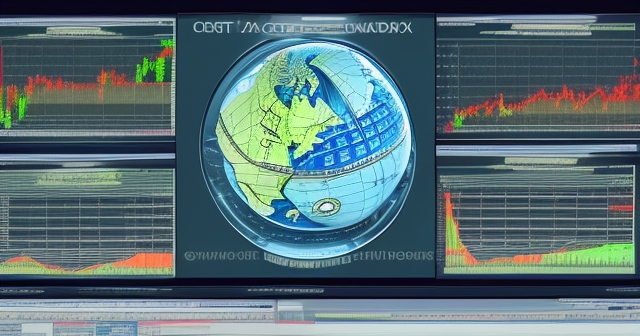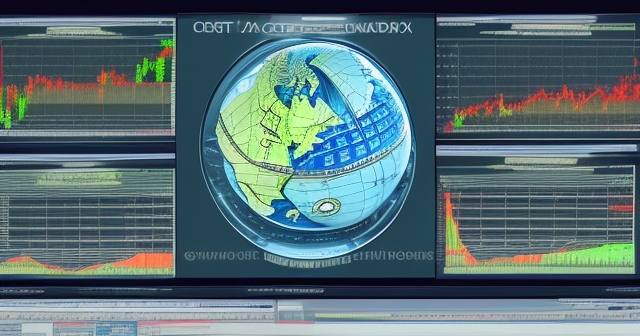Navigating the Forex Market: Your Comprehensive Guide to Understanding Key Drivers
Welcome, aspiring traders and seasoned analysts alike. The world of foreign exchange, or Forex, is a dynamic and often complex arena. It’s a place where global events, economic data, and human psychology converge, creating constant opportunities and challenges. Whether you’re just starting your journey into currency trading or seeking to deepen your understanding of what truly moves the market, this guide is crafted for you. Think of us as your experienced companion, breaking down intricate concepts into digestible insights.
In this exploration, we won’t just point out recent market movements; we’ll delve into the ‘why’ behind them. We’ll dissect the powerful forces that shape currency valuations, from the whispers of central bankers to the roar of economic data releases and the unpredictable currents of global politics. By understanding these fundamental drivers, you equip yourself with a crucial framework for making informed trading decisions. Are you ready to uncover the mechanics that propel the world’s largest financial market?

In the forex market, several critical factors influence trading decisions. Understanding these can enhance your strategies:
- Investor sentiment: It can greatly affect how currencies move in response to news and economic data.
- Central bank policies: Changes in interest rates can lead to significant shifts in currency valuations.
- Global economic indicators: Data releases such as GDP and employment figures can guide trading strategies.
The Mighty Dollar: Understanding Its Influence on Global Currencies
At the heart of most major currency pair discussions lies the United States Dollar (USD). As the world’s primary reserve currency and the denomination for vast amounts of global trade and debt, its strength or weakness has a ripple effect across the entire Forex market. Think of the USD as the sun in our Forex solar system; its gravity significantly influences the orbits of other currencies.
Recently, we’ve observed instances where the USD has shown signs of weakness, contributing to upward movements in pairs like EUR/USD and GBP/USD. But what factors cause this shift? One significant element is often the performance of US bond yields. When yields on US Treasury bonds rise, they can attract foreign investment seeking higher returns, increasing demand for the dollar and pushing its value up. Conversely, a decline in yields can reduce this attractiveness, potentially leading to dollar depreciation. Understanding the relationship between bond yields and the USD is crucial for any trader.
Beyond yields, market sentiment plays a massive role. In periods of global economic uncertainty or risk aversion, investors often flock to the perceived safety of the US Dollar, treating it as a ‘safe haven’ asset. This increased demand strengthens the dollar. Conversely, when risk sentiment is ‘on’ – meaning investors feel more optimistic and willing to take on risk – funds may flow out of safe-haven assets like the USD and into riskier currencies or assets, causing the dollar to weaken. Observing global risk sentiment indicators like equity market performance (e.g., S&P 500, NASDAQ) can offer clues about potential USD movements.

Key Economic Data: The Pulse of the US Economy and the Dollar
If bond yields and market sentiment are influential currents, then major economic data releases are like seismic events for the USD. Reports like the Non-Farm Payrolls (NFP) and Retail Sales are absolute game-changers. Why? Because they provide direct insights into the health and momentum of the US economy, which in turn heavily influences the Federal Reserve’s (the Fed) decisions regarding monetary policy, especially interest rates.
| Economic Data | Importance |
|---|---|
| Non-Farm Payrolls (NFP) | Indicates labor market strength |
| Retail Sales | Reflects consumer spending trends |
| Gross Domestic Product (GDP) | Measures economic performance |
Consider the NFP report, which tracks the number of jobs added or lost in the US economy (excluding farm workers and a few other categories). A strong NFP number signals a robust labor market, suggesting economic growth is solid. This might prompt the Fed to consider maintaining or even hiking interest rates to prevent inflation. Higher interest rates make the dollar more attractive to foreign investors seeking yield, thus strengthening the USD. Conversely, a weak NFP report suggests economic slowdown, potentially leading the Fed to consider cutting rates to stimulate growth. Lower rates make the dollar less appealing for yield, potentially weakening it.
Similarly, US Retail Sales data provides a snapshot of consumer spending, a major driver of the US economy. Strong retail sales indicate healthy consumer confidence and economic activity, reinforcing arguments for tighter monetary policy or at least holding rates steady. Weak sales suggest the opposite, potentially signaling the need for stimulus through rate cuts. As a Forex trader, keeping a close eye on the economic calendar and understanding the potential market impact of these reports is not just advisable; it’s essential. How do you currently prepare for these high-impact data releases?

The Yen’s Puzzle: Decoding Persistent Weakness and Intervention Threats
Shifting our focus across the Pacific, the Japanese Yen (JPY) presents a fascinating case study in recent Forex dynamics. Despite Japan being a major global economy, the JPY has shown persistent weakness against multiple major currencies, including the USD, EUR, GBP, and AUD. We’ve seen pairs like USD/JPY climb to multi-decade highs. This trend is a significant topic of discussion and concern for market participants and Japanese authorities alike.
One of the primary drivers of JPY weakness is the stark contrast in monetary policy between the Bank of Japan (BOJ) and other major central banks like the Fed or the ECB. While other central banks have tightened monetary policy by hiking interest rates to combat inflation, the BOJ has largely maintained its ultra-loose policy, including negative interest rates and yield curve control, aimed at stimulating Japan’s economy. This creates a significant ‘yield differential.’ Investors can earn much higher returns by holding assets denominated in USD, EUR, or GBP compared to JPY assets. This encourages capital to flow out of Japan and into these higher-yielding economies, driving down demand for the Yen and pushing it lower against its peers.
The sustained weakness of the JPY has led to repeated warnings and threats of currency intervention from Japanese officials. Intervention typically involves the Japanese Ministry of Finance selling USD and buying JPY directly in the Forex market to prop up the Yen’s value. While interventions have occurred in the past and can cause sharp, sudden movements, they are generally seen as temporary fixes unless backed by a shift in fundamental policy. The market remains on high alert for potential intervention, making trading JPY pairs particularly volatile. Understanding the delicate balance between the BOJ’s policy goals and the market’s reaction to yield differentials is key when analyzing JPY pairs.
Europe Under the Microscope: Political and Economic Pressures on the Euro and Pound
Europe’s major currencies, the Euro (EUR) and the British Pound (GBP), are currently navigating a complex landscape shaped by significant political events and evolving economic data. Both currencies are facing pressures, albeit from slightly different sources, which heavily influence pairs like EUR/USD and GBP/USD.
For the Euro, upcoming political events, such as potential French elections, are expected to trigger significant Forex volatility. Political uncertainty can cast doubt on future fiscal policies, economic stability, and investor confidence within the Eurozone, potentially leading to capital outflows and pressure on the Euro’s value. Beyond politics, the Euro’s trajectory is heavily influenced by Euro Area inflation data and the European Central Bank’s (ECB) stance. While the ECB has tightened policy, its future actions are highly data-dependent. Slower Euro Area inflation could pave the way for potential rate cuts, which would generally be negative for the Euro, as lower rates reduce the attractiveness of Euro-denominated assets for yield-seeking investors.
| Political Factors | Impact |
|---|---|
| French Elections | Increased volatility in EUR |
| UK Elections | Potential shifts in GBP dynamics |
The British Pound has recently seen gains against a weaker USD. However, it faces its own set of challenges and potential drivers. The outcome of recent UK elections, particularly if resulting in a significant shift in government (like a Labour landslide), introduces uncertainty regarding future fiscal policy. Changes in government spending, taxation, and economic priorities can significantly impact investor sentiment towards the UK economy and, by extension, the Pound. Furthermore, the Bank of England’s (BoE) monetary policy decisions, influenced by incoming data like inflation and employment figures, are crucial. Anticipation of potential BoE rate cuts, if economic data softens, could weigh on the Pound. Therefore, staying informed about political developments and economic data releases from both the Eurozone and the UK is vital for trading EUR and GBP pairs.
If you’re looking to trade these major European pairs or explore other global currencies, choosing the right platform is a crucial first step. In choosing a trading platform, Moneta Markets‘s flexibility and technical advantages are worth mentioning. It supports MT4, MT5, Pro Trader and other mainstream platforms, combining high-speed execution and low spread settings to provide a good trading experience.

Central Banks: The Architects of Monetary Policy and Currency Valuation
We’ve mentioned central banks repeatedly because they are arguably the most powerful actors influencing currency markets. Institutions like the Federal Reserve (Fed), the European Central Bank (ECB), the Bank of England (BoE), the Bank of Japan (BOJ), and others set monetary policy, primarily through adjusting interest rates and using tools like quantitative easing or tightening. These policies directly impact inflation, economic growth, and the attractiveness of a country’s currency.
The market constantly tries to anticipate central bank actions. This anticipation, often referred to as ‘rate expectations,’ is priced into currency valuations. For instance, if the market increasingly expects the Fed to cut interest rates sooner than previously thought, this ‘dovish’ shift tends to weaken the USD as the prospective yield advantage diminishes. Conversely, if economic data suggests a central bank might need to keep rates higher for longer (‘hawkish’ stance), this typically strengthens the currency.
Central bankers’ speeches, meeting minutes, and press conferences are scrutinised by traders for clues about their future intentions. Even subtle changes in language can signal a shift in policy direction. This is why terms like “data-dependent” are frequently used – central banks emphasize that their future decisions will hinge on how incoming economic data unfolds. Understanding each major central bank’s mandate, current focus (e.g., fighting inflation vs. stimulating growth), and communication style is fundamental to Forex analysis. Do you follow the commentary from central bankers? How do you think their words impact your trading decisions?
The Ripple Effect: How Commodities, Cryptocurrencies, and Indices Influence Forex
The Forex market doesn’t exist in isolation; it’s interconnected with other financial markets, including commodities, cryptocurrencies, and stock indices. Understanding these inter-asset correlations can provide valuable insights into potential currency movements.
Commodities, such as Gold, Oil, and Natural Gas, often have strong relationships with certain currencies. Commodity-exporting countries like Canada (CAD) or Australia (AUD) often see their currencies strengthen when the prices of their major export commodities rise. Gold, traditionally seen as a safe-haven asset and a hedge against inflation, often has an inverse relationship with the US Dollar. When the USD weakens, Gold prices may rise as it becomes cheaper for holders of other currencies, and vice versa. Concerns over geopolitical risk or trade tensions (like potential tariffs) can also boost demand for Gold as a safe haven, potentially influencing USD dynamics.
Stock indices, like the S&P 500, NASDAQ, or Dow Jones, often reflect broader market sentiment and risk appetite. When stock markets are rising (a ‘risk-on’ environment), riskier currencies (like AUD, NZD) may strengthen against traditional safe havens (like USD, JPY). Conversely, during periods of market stress and declining stocks (‘risk-off’), safe havens tend to appreciate. While direct correlations can sometimes break down, observing stock market trends provides a general pulse of investor confidence.

Even the burgeoning cryptocurrency market can sometimes offer clues. While not as directly correlated as commodities or indices, significant movements in major cryptocurrencies like Bitcoin or Ethereum can occasionally reflect shifts in broader speculative appetite or investor sentiment, which might indirectly impact capital flows and risk-sensitive currencies. Recognizing these cross-market dynamics adds another layer to your analysis, helping you see the bigger picture beyond just currency pairs.
Political Landscape: Elections, Tariffs, and Global Stability
Beyond economic data and central bank policy, political events can inject significant volatility and uncertainty into the Forex market. Elections, changes in government, trade policy disputes, and geopolitical tensions can all impact a country’s economic outlook, investor confidence, and currency value.
Recent examples highlight this perfectly. The outcome of the UK election introduces potential shifts in fiscal policy that markets are now trying to price into the Pound. Similarly, the anticipation of French elections is creating uncertainty around the Euro. Political instability or unexpected election results can lead to capital flight as investors become nervous about the future stability or economic direction of a country.
Trade policy is another potent political driver. Discussions around potential tariffs or trade wars (like the prospect of “Trump round 2”) can increase market concern, impacting trade-sensitive economies and currencies. For instance, threats of tariffs can weigh on the currencies of countries heavily reliant on exports or those that might be targeted, while simultaneously boosting demand for safe-haven assets like Gold. Geopolitical events, such as ongoing conflicts or diplomatic tensions, can also increase risk aversion and influence capital flows, favouring safe-haven currencies and potentially weakening those associated with increased risk.
Staying informed about the political calendar and understanding the potential economic implications of political decisions is therefore a vital part of fundamental Forex analysis. Political risk is often harder to quantify than economic data, but its impact can be profound and swift.

If you are exploring global trading opportunities and considering which broker to use, Moneta Markets, with its multiple regulatory certifications including FSCA, ASIC, and FSA, provides regulatory assurance for global trading. They also offer additional support like segregated client funds, free VPS, and 24/7 Chinese customer service, making them a preferred choice for many traders.
Technical Analysis: Finding Opportunities in Price Action
While fundamental factors drive the long-term trends in Forex, technical analysis provides essential tools for identifying potential entry and exit points, managing risk, and understanding market psychology reflected in price action. Technical analysis involves studying historical price and volume data to forecast future movements. Think of it as reading the market’s behaviour patterns.
Experienced traders use a variety of technical tools, including charting patterns (like head and shoulders, flags, pennants), indicators (like moving averages, RSI, MACD), and support and resistance levels. Support levels are price points where buying interest is strong enough to potentially halt a decline, while resistance levels are where selling pressure may be sufficient to stop a rally. These levels act as potential barriers or targets for price movements.
| Technical Tools | Purpose |
|---|---|
| Chart Patterns | Identify potential price movements |
| Indicators | Help confirm trends |
| Support/Resistance | Determine entry/exit points |
Technical analysis can help validate or question fundamental analysis. For example, if fundamental factors suggest a currency pair should rise, but technical indicators show strong resistance overhead or bearish patterns forming, it might signal that the market is not yet fully accepting the fundamental view, or that the upward move is facing temporary hurdles. Technical forecasts often highlight specific price targets and invalidation levels – points where the technical setup is no longer considered valid. Combining fundamental understanding with technical execution is a powerful approach for many traders.
Remember, technical analysis is not about predicting the future with certainty, but rather about identifying probabilities and managing risk based on historical price behaviour. It provides a structured way to approach the market and execute trades based on objective criteria. Do you primarily rely on technical indicators, chart patterns, or a combination when making trading decisions?
Market Sentiment and Risk: The Psychological Undercurrents
Underneath the layers of economic data, central bank policies, and political events flows the powerful current of market sentiment – the overall attitude or feeling of investors and traders towards the market or specific assets. This sentiment can range from highly optimistic (‘risk-on’) to deeply pessimistic (‘risk-off’), and it significantly influences capital flows and currency valuations.
In a ‘risk-on’ environment, fueled by positive economic outlooks or reduced geopolitical tensions, investors are typically more willing to invest in assets perceived as riskier but offering higher potential returns. This often benefits growth-sensitive currencies (like AUD, NZD) and sometimes riskier assets like certain commodities or equities. In contrast, a ‘risk-off’ environment, triggered by uncertainty, fear, or negative news, sees investors withdrawing from riskier assets and seeking safety in traditional safe havens like the US Dollar, Japanese Yen, Swiss Franc (CHF), and Gold.
Risk assessment is an ongoing process for traders. They evaluate potential threats (like elections, trade wars, unexpected data) and opportunities, adjusting their positions accordingly. Measures of market volatility, such as the VIX index, can offer insights into the level of fear or complacency in the market. While not directly a currency, understanding the VIX can provide context for potential shifts in sentiment that might impact Forex pairs.
Recognizing whether the prevailing market mood is risk-on or risk-off helps you understand the broader flow of capital and position your trades accordingly. It’s a reminder that even with solid fundamental and technical analysis, the collective psychology of the market participants plays a significant role in short-term price movements.
For anyone starting out in Forex trading or looking to refine their approach, gaining a deep understanding of these market drivers is paramount. If you are considering beginning Forex trading or exploring more CFD products, Moneta Markets is a platform worth considering. Based in Australia, it offers over 1000 financial products, suitable for both novice and professional traders.
Putting It All Together: Integrating Analysis for Informed Trading
Successful Forex trading rarely relies on a single piece of information or one type of analysis. Instead, it’s about integrating various perspectives – fundamental, technical, sentiment, and political – to form a comprehensive view of the market. Think of yourself as a detective, gathering clues from multiple sources to build a compelling case.
Fundamental analysis provides the ‘why’ – explaining the underlying forces driving long-term trends. Technical analysis provides the ‘when’ and ‘where’ – helping you time entries/exits and identify key price levels. Sentiment analysis gives you a feel for the market’s current mood and potential short-term biases. Political analysis highlights potential tail risks and sources of unexpected volatility.
A common pitfall for new traders is focusing too narrowly on just one aspect, like a single economic indicator or a specific chart pattern, without considering the broader context. For instance, a technically bullish setup might fail if a major, unexpected political event shifts sentiment dramatically. Similarly, strong economic data might not boost a currency if the central bank signals that it’s already factored in or if other, more dominant global themes are at play.
Developing a robust trading plan involves considering inputs from all these areas. How does the upcoming NFP report align with the prevailing technical trend on EUR/USD? How might potential French election outcomes impact the Euro’s reaction to ECB commentary? What does the current level of market risk appetite suggest about the sustainability of the recent JPY weakness?
Looking Ahead: Anticipating Future Market Movers
The Forex market is constantly looking forward, trying to discount future events and potential policy shifts. As we conclude this guide, it’s important to consider what key events and themes are likely to shape the market in the near future. Staying ahead involves continuously monitoring the economic calendar, political developments, and central bank communications.
Upcoming data releases, such as further inflation reports, GDP figures, and employment statistics from major economies, will be critical inputs for central banks and traders alike. Any signs of inflation persisting or economies slowing faster than expected could trigger significant adjustments in rate expectations and, consequently, currency valuations.
Political landscapes, particularly in Europe and the US (with upcoming elections and potential shifts in trade policy), will remain significant sources of potential volatility. Traders will be watching closely for policy announcements and their likely economic consequences.
Furthermore, monitoring cross-market developments – such as trends in commodity prices (especially Oil and Gold), movements in major stock indices, and even significant shifts in the cryptocurrency space – can provide valuable context for your Forex trading decisions.
Ultimately, mastering Forex trading is a continuous learning process. It requires diligence, adaptability, and a commitment to understanding the complex web of global forces that drive currency movements. By focusing on core drivers like central bank policy, economic data, political risk, and leveraging both fundamental and technical analysis, you build a solid foundation for navigating this exciting market. We hope this comprehensive guide has provided you with valuable insights and empowered you to approach the Forex market with greater confidence and knowledge.
forex testFAQ
Q:What factors influence currency movements in the Forex market?
A:Factors include central bank policies, economic data releases, and market sentiment.
Q:How important is technical analysis in Forex trading?
A:Technical analysis is crucial for identifying entry/exit points and managing risk based on market behavior.
Q:What role do political events play in the Forex market?
A:Political events can create volatility and influence investor confidence, leading to currency fluctuations.
